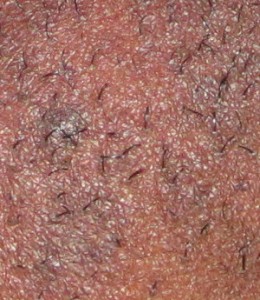Electrolysis and Black Skin
Electrolysis has a similar effect on all skin types. There will be minor swelling on the face after treatment and there will be scabbing on the body after an effective electrolysis treatment. These side effects occur regardless of skin colour or type.
There is one side effect of electrolysis that is related to skin colour and that is postinflammatory hyperpigmentation (PIH). The colour of the skin determines the degree of hyperpigmentation present after electrolysis. On light skin hyperpigmentation often appears as a pinkish hue that can last for weeks or months. On darker skin, particularly on people of African or Southeast Asian descent, hyperpigmentation is more significant because it appears as darker spots on the skin and these can be more difficult to camouflage. These spots can also be more stubborn in fading although they do eventually fade. Hyperpigmentation is more common on the body because higher treatment energy is used, however, it can occur after treating the coarse chin and beard hairs of people with both black and brown skin.
The clients themselves are in the best position to predict whether they are at risk of hyperpigmentation based on how their skin reacts to minor traumas like pimples, cuts and scrapes. If your skin has lots of pigmentation issues at the best of times then you need to proceed with electrolysis very slowly (maxiumum 15 or 30 minute treatments).
In terms of how treatment is performed I think the most important consideration for electrolysis and black skin is to ensure the electrologist uses an insulated probe. The reason for this is that the insulation will protect the surface of the skin, thereby decreasing the risk of hyperpigmentation. It’s difficult to eliminate the risk entirely because an electrologist MUST use a healthy dose of current to actually kill your hair follicle.
Treatment Outcome For Electrolysis And Black Skin
I think women with brown or black skin should expect some level of hyperpigmentation as a result of electrolysis if they expect the treatments to actually work. This doesn’t mean that you will definitely see it, but it’s unrealistic to expect that you definitely won’t and that it’s completely the fault of the electrologist if you do. Postinflammatory hyperpigmentation is almost a certainty after an effective body treatment, however, it is not as common on the face unless the hair is extremely coarse.
The good news is that removing the hair is a step in helping to heal the hyperpigmentation. I’ve noticed on all skin tones that the hair growth itself is a factor in the hyperpigmentation problem. Here is an example of hyperpigmentation on black skin as a result of the growth of hair itself.
The areas where there is hair growth are noticeably darker than the areas without, thus, you can see how permanently removing the hair is essential in clearing up the skin.Often you’ll notice discolouration around the opening of the hair follicle, especially if the hair is coarse. Once they hair doesn’t grow anymore the skin will start to heal and hyperpigmentation will cease to be a problem.
The best products to treat hyperpigmentation are tretinoin (Retin-A) and other products that have an exfoliating (or rejuvenating) effect on the skin. Since hyperpigmentation is caused by an overproduction of melanin, skin lightening creams may also contribute to lightening the spots. It’s important to remember that regardless of what you use on your skin sunlight must be avoided because it aggravates hyperpigmentation problems.
In my next post I will address specific questions on black hair and electrolysis.
Further Reading:
Post Inflammatory Hyperpigmentation After Electrolysis Hair Removal


